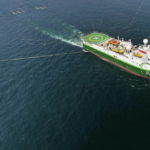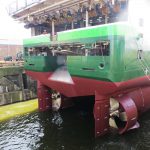The 3D seismic survey vessel »Polarcus Naila« got a major refit carried out at Damen’s Shipdock Amsterdam yard, during which time she became the first vessel to be fitted with the new Caterpillar Propulsion twin fin system
Developed in partnership with Odense Maritime Technology (OMT) and Scandinavian Marine Group (SMG), the twin fin system is a diesel[ds_preview] electric propulsion package that is designed to save fuel, reduce emissions and enhance overall vessel performance. The vessel’s operator, Dubai based Polarcus DMCC, has reported significant operating and cost benefits as a result of the decision to switch from the azimuth thruster arrangement that was originally on the vessel to this new solution.
Delivered in 2010, »Polarcus Naila« is a modern seismic vessel built to the Ulstein SX124 design. As Mr Zickerman, Executive Vice President Polarcus, points out, »Around 85% of the time »Polarcus Naila« is operating effectively as a tug, towing a huge array of highly valuable equipment behind the ship, often in variable weather conditions. Being at high load all the time puts immense pressure on the propulsion system, so it is vitally important that its propulsion system functions with the highest degree of reliability. Stopping this vessel is simply not an option for both technical and commercial reasons. Downtime has to be avoided at all costs.«
Due to the extremely high level of performance and reliability required, the operator decided that the vessel’s propulsion technology could be further enhanced. Problems had been encountered with vibration caused by gear wearing, for example, as well as other issues and so a decision was taken to look for alternatives. Discussions were held with three different design houses. The criteria were: A 100% increase in redundancy; a 35% increase in bollard pull; 30% greater endurance; silent propulsion; a short conversion timeframe; and a rapid pay-back in terms of bottom line impact.
The solution put forward by the Caterpillar Propulsion team came out on top, with its twin fin system. This arrangement protects all of the propulsion system’s mechanical parts within the hull profile, while maintaining high levels of manoeuvrability and, crucially, making gains in terms of reliability and efficiency.
Initially conceived for vessels in harsh operating environments, such as the Arctic, the twin fin system comprises a compact electric motor and gearbox configuration connected via a short drive shaft. The shaft rotates a pair of controllable pitch propellers, whose performance is enhanced by two tailor-made fins attached to the hull. The key transmission elements of the system are accessible from inside the vessel, facilitating maintenance and potentially avoiding the need for the vessel to enter dry dock to carry out repairs. The gear and electric motors, as well as the stern tube inner sealing can be exchanged by the crew through the deck. As well as designed to be both robust and reliable, the Caterpillar Propulsion twin fin system according to the producer offers increased thrust and requires a lower power input as a result of having larger propellers running at lower shaft speeds, as well as minimal mechanical loss. Hydrodynamically-designed fins ensure homogenous water flow to the propellers, which in turn shall lead to lower fuel consumption, reduced emissions and less noise.
The upgrade to the vessel’s propulsion system was completed at a cost of around 12mill.$. In this case the fins were supplied pre-fabricated, fully equipped, and already tailored to the design and operating requirements of »Polarcus Naila«.
Polarcus says the vessel now has increased bollard pull and reduced operating costs, with fuel consumption levels for propulsion running at 30% below that previously registered when operating with azimuth thrusters. »We are confident the conversion will have a payback time of less than three years,« says Zickerman.
Now that it has this first project under its belt, Caterpillar Propulsion is marketing this concept as a solution to a wide range of vessel types using diesel-electric propulsion, from offshore support vessels to cruise ships. Mattias Hansson, Caterpillar Marine senior project manager, says, «In addition to being the most compact of its kind for offshore vessels, the system has proved to be a robust performer in operations in the field, without diminishing manoeuvrability. It achieves better overall performance and increased cargo loading capacity in comparison with azimuth thruster operations.« Originally Caterpillar Propulsion developed the twin fin system with OMT and SMG as a solution for vessels operating in the Arctic, making their propulsion systems less vulnerable to damage. However, Hansson points out, »As the innovative concept has been engineered into vessels we have been pleased to see not only increased reliability but improvements in fuel consumption and thrust performance as well.«


















